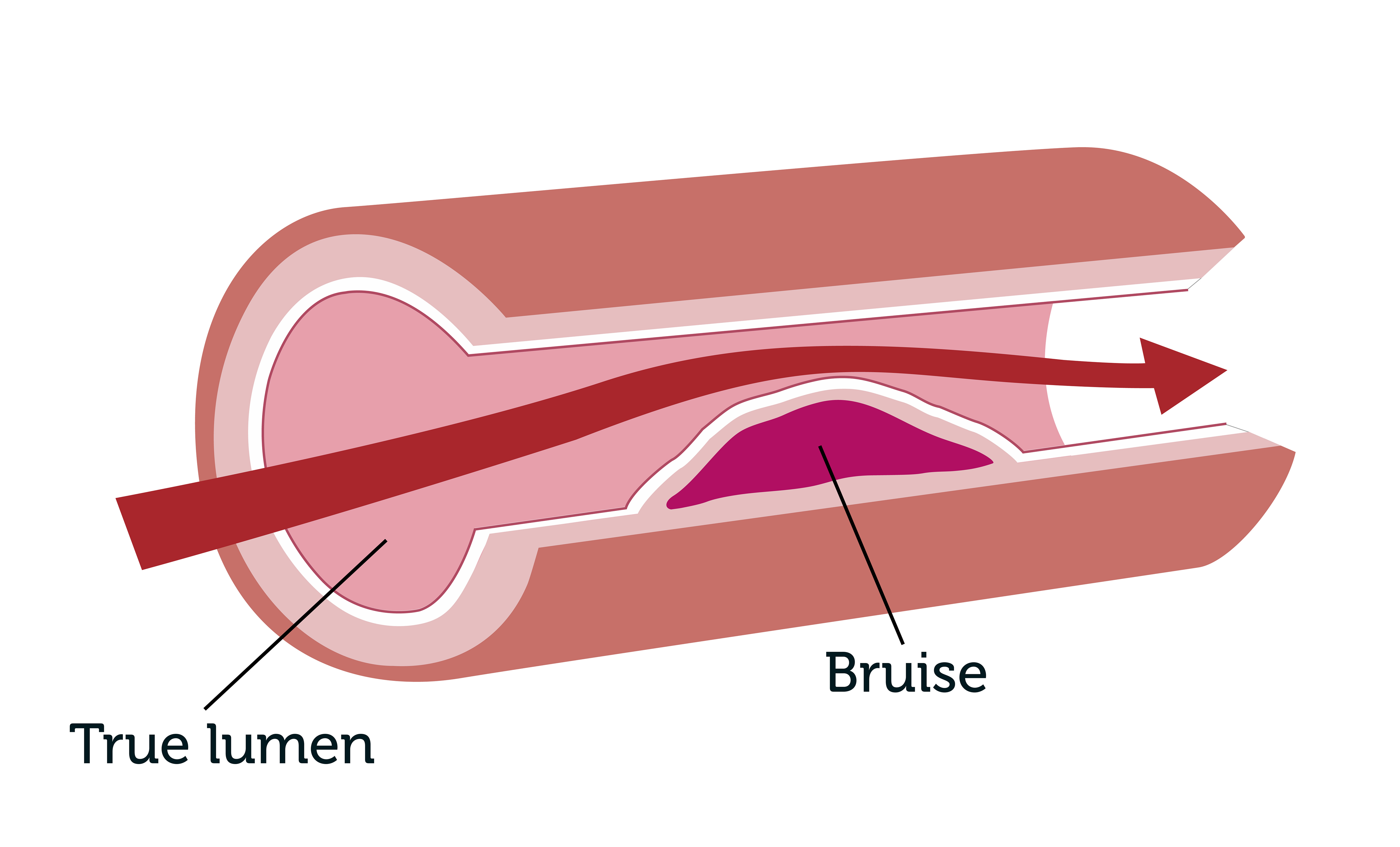Spontaneous Coronary Artery Dissection (SCAD) is an uncommon heart condition that can’t be predicted or prevented – yet.

A bruise (sometimes called a tear) develops in the wall of a coronary (heart) artery, creating a 'false lumen', which compresses the artery (the true lumen) and prevents normal blood flow. This leads to a heart attack and occasionally heart failure or cardiac arrest. SCAD can, very rarely, can be fatal.
The cause of false lumen formation is unclear but growing evidence suggests that micro-vessels within the artery wall haemorrhage, creating a bruise (called an intramural haematoma), which causes vessel narrowing and sometimes ruptures to form a dissection flap.
Patients who have had a SCAD may be treated just with medication or need surgical intervention, such as stents or even bypass surgery.
SCAD has been reported across a wide age range (18-84 years) but the majority of cases are in young- to middle-aged women with an average age of 50. Around 10% of patients have their SCADs around the time of pregnancy, with 21-27% of heart attacks in pregnancy and 50% of post-partum coronary events reportedly due to SCAD. For more about P-SCAD, have a look at these videos.
Around 10% of patients are male and, because SCAD patients are predominantly female and it's thought there is a hormonal association, this is an area of interest to researchers as men don't go through the hormonal fluctuations women do, so may provide clues about what causes SCAD.
SCAD patients may have few or none of the traditional risk factors associated with heart disease (atherosclerosis). More research is needed to understand why fit, healthy people have SCADs.
Most patients find that being diagnosed with SCAD is a shock as it comes out of the blue. You may be worried and scared and doubtless have many questions. If you are a new patient, a good place to start is the Recovery section and the SCAD Information Pack.
SCAD can have an impact on your emotional wellbeing, but there is help and support, including our Buddy Service, where you can talk to another patient who can help you navigate your post-SCAD journey. You are not alone!
SCAD Explained
We don’t yet know what causes SCAD. Some associations have been described with:
What is SCAD?
- Pregnancy and post-partum (shortly after delivery of a baby)
- Menopause
- Fibromuscular Dysplasia (FMD)
- Hereditary connective tissue disorders
- Extreme stress
- Extreme exercise or emotional stress
Watch this video where Dr David Adlam, who is leading the UK research, explains more about SCAD.
Recent research has identified genetic variants that confer a higher risk of having a SCAD, but it is not caused by a single gene in the same way hereditary diseases are. Use the Download form to request our summary of the May 2023 GWAS (Genome Wide Association Study) paper about genetics and SCAD.
Download our SCAD explained information sheet below for more about what we think happens during a SCAD.
There’s lots of medical jargon about heart conditions and SCAD, so download our Jargon Buster for some explanations and you can also download a list of questions you might want to ask your healthcare professionals.
Resources
Beat SCAD Conference 2018
Beat SCAD Conference 2023
Dr Alice Wood's research on sub-groups including male SCADs
Research update 2021 (starts at 3 mins)
Dr Alice Wood discusses research into male SCADs (2020)
Short introduction to Pregnancy-related SCAD
Bronnach's story
Geri's story
Zoe's story
Introduction to Pregnancy-related SCAD (P-SCAD)
Dr Abi Al-Hussaini on P-SCAD
Advice to healthcare professionals from P-SCAD patients
Research update 2021 (starts at 32 mins)
FAQs
Spontaneous Coronary Artery Dissection (SCAD) is an uncommon heart condition that can’t be predicted or prevented.
A bruise (sometimes called a tear) develops in the wall of a coronary (heart) artery, creating a 'false lumen', which compresses the artery (the true lumen) and prevents normal blood flow. This leads to a heart attack and occasionally heart failure or cardiac arrest which, very rarely, can be fatal.
The cause of false lumen formation is unclear but growing evidence suggests that micro-vessels within the artery wall haemorrhage, creating a bruise (called an intramural haematoma), which causes vessel narrowing and sometimes ruptures to form a dissection flap.
Watch this video where Dr David Adlam, who is leading the UK research, explains more about SCAD.
A bruise or tear develops in the wall of a coronary (heart) artery, creating a 'false lumen', which compresses the artery (the true lumen) and prevents normal blood flow. This leads to a heart attack and occasionally heart failure or cardiac arrest which, rarely, can be fatal.
The cause of false lumen formation is unclear but growing evidence suggests that micro-vessels within the artery wall haemorrhage, creating a bruise (called an intramural haematoma), which causes vessel narrowing and sometimes ruptures to form a dissection flap. We don’t yet know what causes SCAD. Some associations have been described with:
- Pregnancy and post-partum
- Menopause
- Fibromuscular Dysplasia (FMD)
- Hereditary connective tissue disorders
- Extreme stress
- Extreme exercise or emotional stress
Watch this video where Dr David Adlam, who is leading the UK research, explains more about SCAD.
Recent research has identified genetic variants that confer a higher risk of having a SCAD, but it is not caused by a single gene in the same way hereditary diseases are.
